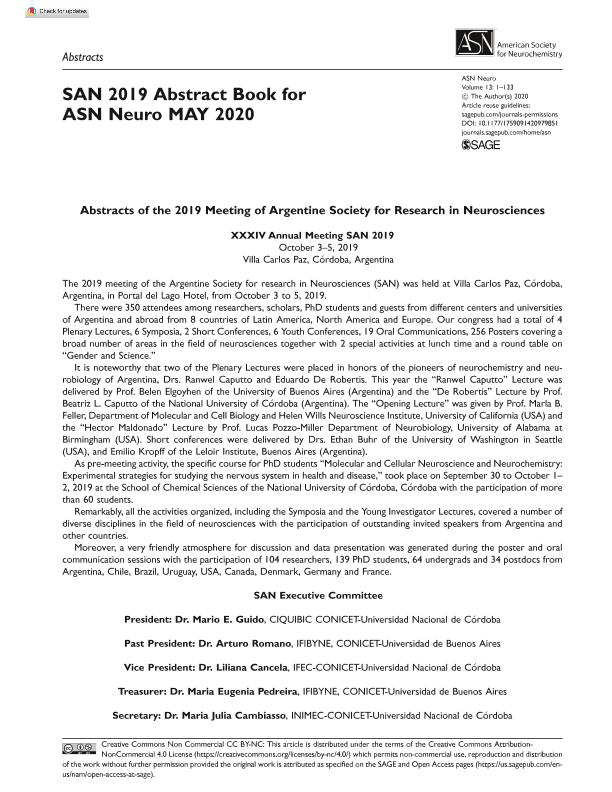Mostrar el registro sencillo del ítem
dc.contributor.author
Soldi, Natalia

dc.contributor.author
Ferella, Luciana

dc.contributor.author
Schinder, Alejandro Fabián

dc.contributor.author
Piatti, Veronica del Carmen

dc.date.available
2022-08-08T15:48:05Z
dc.date.issued
2020
dc.identifier.citation
When does the mammalian GPS use the dentate gyrus in everyday challenges of spatial navigation?; XXXIV Annual Meeting of the Argentine Society for Research in Neuroscience; Argentina; 2019; 1-2
dc.identifier.uri
http://hdl.handle.net/11336/164580
dc.description.abstract
Our mammalian GPS, Global Positioning System, is made of diverse brain structures such as the dentate gyrus (DG) of the hippocampus. This is one of the most plastic brain regions because it has adult neurogenesis and this process is modulated by the animal experiences.The most accepted function of the DG and its new neurons is the discrimination of similar spatial contexts. However, their contribution in an ordinary behaviour remains unknown. We started investigating the hypothesis that the DG would be necessary to solve difficult spatial challenges but not easy ones in a goal guided behaviour. Therefore, adult mice were infected with AAV flex-hM4Di plus CAG-Cre retrovirus in the DG to allow chemogenetic manipulation of neuronal activity in mice navigating in a crossword maze after the i. p. injection of the synthetic agonist clozapine-N-oxide (?CNO?) or its vehicle (?control?). In a single day mice had to learn two shortest paths to a new reward location. We designed spatial routes of two levels of cognitive demand and evaluated mice performance with or without chemogenetic inhibition (CNO vs. control). Easy and difficult journeys were equally solved and learnt by mice under control condition. However, mice receiving CNO could only learn easy spatial trajectories but not the difficult ones (p = 0.01, Wilcoxon signed rank test, N = 4 mice). Therefore, our preliminary data suggest that the DG is required by the GPS during spatial navigation in complex mnemonic challenges.
dc.format
application/pdf
dc.language.iso
eng
dc.publisher
SAGE Publications

dc.rights
info:eu-repo/semantics/openAccess
dc.rights.uri
https://creativecommons.org/licenses/by-nc-sa/2.5/ar/
dc.subject
CROSSWORD MAZE
dc.subject
hM4Di
dc.subject
NOVELTY
dc.subject
CLOZAPINE-N-OXIDE
dc.subject.classification
Neurociencias

dc.subject.classification
Medicina Básica

dc.subject.classification
CIENCIAS MÉDICAS Y DE LA SALUD

dc.title
When does the mammalian GPS use the dentate gyrus in everyday challenges of spatial navigation?
dc.type
info:eu-repo/semantics/publishedVersion
dc.type
info:eu-repo/semantics/conferenceObject
dc.type
info:ar-repo/semantics/documento de conferencia
dc.date.updated
2022-03-16T20:13:10Z
dc.journal.pagination
1-2
dc.journal.pais
Estados Unidos

dc.description.fil
Fil: Soldi, Natalia. Consejo Nacional de Investigaciones Científicas y Técnicas. Oficina de Coordinación Administrativa Parque Centenario. Instituto de Investigaciones Bioquímicas de Buenos Aires. Fundación Instituto Leloir. Instituto de Investigaciones Bioquímicas de Buenos Aires; Argentina
dc.description.fil
Fil: Ferella, Luciana. Consejo Nacional de Investigaciones Científicas y Técnicas. Instituto de Biología y Medicina Experimental. Fundación de Instituto de Biología y Medicina Experimental. Instituto de Biología y Medicina Experimental; Argentina
dc.description.fil
Fil: Schinder, Alejandro Fabián. Consejo Nacional de Investigaciones Científicas y Técnicas. Oficina de Coordinación Administrativa Parque Centenario. Instituto de Investigaciones Bioquímicas de Buenos Aires. Fundación Instituto Leloir. Instituto de Investigaciones Bioquímicas de Buenos Aires; Argentina
dc.description.fil
Fil: Piatti, Veronica del Carmen. Consejo Nacional de Investigaciones Científicas y Técnicas. Oficina de Coordinación Administrativa Parque Centenario. Instituto de Investigaciones Bioquímicas de Buenos Aires. Fundación Instituto Leloir. Instituto de Investigaciones Bioquímicas de Buenos Aires; Argentina
dc.relation.alternativeid
info:eu-repo/semantics/altIdentifier/url/https://journals.sagepub.com/doi/pdf/10.1177/1759091420979851
dc.relation.alternativeid
info:eu-repo/semantics/altIdentifier/url/https://journals.sagepub.com/doi/full/10.1177/1759091420979851
dc.relation.alternativeid
info:eu-repo/semantics/altIdentifier/doi/http://dx.doi.org/10.1177/1759091420979851
dc.conicet.rol
Autor

dc.conicet.rol
Autor

dc.conicet.rol
Autor

dc.conicet.rol
Autor

dc.coverage
Nacional
dc.type.subtype
Reunión
dc.description.nombreEvento
XXXIV Annual Meeting of the Argentine Society for Research in Neuroscience
dc.date.evento
2019-10-03
dc.description.paisEvento
Argentina

dc.type.publicacion
Journal
dc.description.institucionOrganizadora
Sociedad Argentina de Investigación en Neurociencias
dc.source.revista
ASN Neuro
dc.date.eventoHasta
2019-10-05
dc.type
Reunión
Archivos asociados
